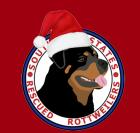HISTORY
| The Rottweiler is said to be descended from the drover dogs of ancient Rome. These mastiff- type dogs accompanied the Roman Legions across the Alps herding their cattle and guarding their camps. One such camp, on the banks of the Neckar River in what is now southern Germany, was the origin of the town of Rottweil (named for the red tile roofs of the villas built by the Romans). Through the mid-1800's, the cattle trade flourished in Rottweil, as did the Rottweiler Metzgerhund (butcher dog), who drove the cattle to market and returned with the filled purses of their masters around their necks. As rail transportation became the primary means of bringing cattle to market, the dogs were used less frequently. Legend has it that by 1905 there was but one Rottweiler left in the town of Rottweil. By the early 1900's though, the Rottweiler gained popularity as a police dog. Several Clubs were formed, and in 1921 united as the Allgemeiner Deutscher Rottweiler Klub (ADRK). In 1931, the first Rottweiler was admitted to the AKC Stud Book. Through the 1970's, the Rottweiler was a fairly uncommon dog in the United States, ranking in the middle of AKC registered breeds in terms of number of dogs registered. In the early 1980's the Rottweiler began a meteoric rise in popularity, and has been the second most popular AKC breed since 1992. |
CHARACTERISTICS AND TEMPERAMENT
|
The Rottweiler is a medium-large, powerful dog. His compact and substantial build denotes great strength, agility and endurance. On average, males will range from 95 to 135 lbs and 24" to 27" at the shoulder. They are more massive throughout with larger frame and heavier bone than bitches. Bitches will range from 80 to 100 lbs and from 22" to 25" at the shoulder. Animals can be found which are taller or shorter than these measurements, however, they are not considered typical by the breed standard. The Rottweiler is ALWAYS black, with clearly defined markings on cheeks, muzzle, chest and legs as well as over both eyes, that range from tan to deep mahogany. His coat is straight, coarse and of medium length, with an undercoat varying in degree based on climatic conditions. Please note, Red, Blue, White, Liver are NOT RARE Rottweiler colors; they are unacceptable colors and most likely the result of interbreeding Rottweilers with other breeds of dogs. The Rottweiler is a calm and self-confident dog, who has an inherent desire to protect home and family. Personality may range from highly affectionate to extremely aloof. He is not shy nor highly excitable. He is an intelligent and highly trainable dog. He is also very much a companion, often following their family members from room to room in the home. Because of his size and strength, it is imperative that he receive proper socialization and obedience training from an early age. Nervous, shy, excitable or hyperactive individuals are exhibiting traits which are undesirable in an animal the size and strength of the Rottweiler and should be avoided. |
AGGRESSIVENESS/PROTECTIVE INSTINCT
|
These traits vary with the individual dog to some degree, although all have a strong territorial instinct and will defend their master's home, car and property from intruders. Rottweilers have also been known to bully or bluff their owners or other people, a trait that is most disconcerting. This problem is easily prevented through early obedience training and the development of a mutually rewarding working relationship. Many families have purchased a Rottweiler for it's protectiveness, only to discover that it brings with it a considerable moral and legal responsibility. Problems arise quickly; the dog may not be able to distinguish between a bear-hug greeting of a family member, or a cherished friend, and the hostile advances of an intruder, particularly if the greetings between parties includes loud shouts, laughter or screams. Dogs must be carefully schooled to accept your friends into your home but physical contact should be approached carefully until the dog realizes that you belong. Strangers must never come into your yard unannounced, the dog doesn't know the difference between your brother and a burglar. Although the Rottweiler does not usually bite without provocation, even being cornered and held by one of these dogs is a very unnerving experience for meter men, delivery persons or neighbors wandering into the yard while the owner is absent. People expected to be in contact with the dog while the owners are absent should be thoroughly familiar with the dog.
American Rottweiler Club, Inc. c 1996 |


















